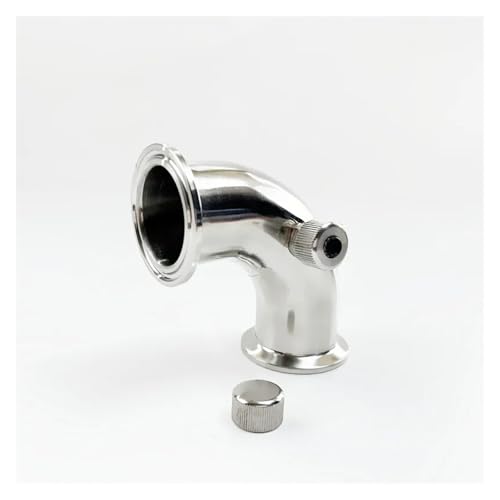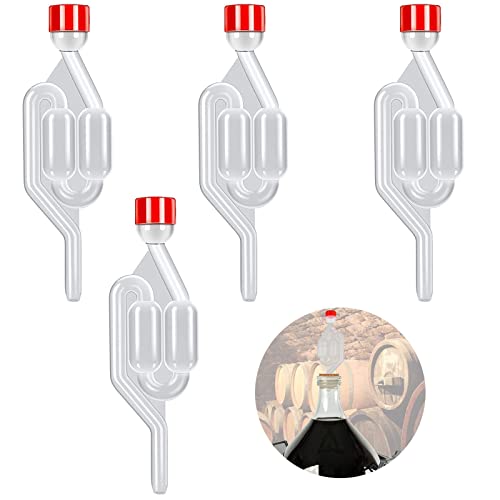As per title. I've seen this phrase crop up a number of times and have not been able to find it in the glossary: can any helpful bod explain exactly what it is and does it need to be removed/filtered before fermentation? :wha:
You are using an out of date browser. It may not display this or other websites correctly.
You should upgrade or use an alternative browser.
You should upgrade or use an alternative browser.
Can anyone explain the cold break please?
- Thread starter WelshPaul
- Start date

Help Support The Homebrew Forum:
This site may earn a commission from merchant affiliate
links, including eBay, Amazon, and others.
Swift Pint
Landlord.
- Joined
- Apr 23, 2011
- Messages
- 558
- Reaction score
- 0
Cold break is the proteins that settle out of the wort as you chill it post boil.
As far as I'm aware they lead to hazy beer if the wort is not chilled fast enough for them to form and settle out from the beer.
I dont think its anything to worry about really, unless you want super clear beer.
Have a read of this, he mentions "stability problems", but not really sure how much of an issue this is...!
http://www.howtobrew.com/section1/chapter7-4.htm
As far as I'm aware they lead to hazy beer if the wort is not chilled fast enough for them to form and settle out from the beer.
I dont think its anything to worry about really, unless you want super clear beer.
Have a read of this, he mentions "stability problems", but not really sure how much of an issue this is...!
http://www.howtobrew.com/section1/chapter7-4.htm
Swazi
Regular.
WelshPaul said:As per title. I've seen this phrase crop up a number of times and have not been able to find it in the glossary: can any helpful bod explain exactly what it is and does it need to be removed/filtered before fermentation? :wha:
Above response is simple and correct. To answer your question... the cold break doesn't have to be removed or filtered out before ferment. Lots of home brewers and most commercial breweries use counter flow wort chillers, which means cold break is formed on the way to the FV and does indeed wind up in the FV. There are arguments for and against this though, but I wouldn't worry about it. If you use an immersion chiller then the cold break will form in your boiler and will be filtered out by your hops before going to FV.
What is the cold break?
Well it's actually the same as the hot break. . . . just smaller. The hot break is formed by the decomposition of the high molecular weight proteins with the heat and movement of the boil (and the reduction in pH as the boil proceeds). If you take a sample of wort every 10 minutes through the boil these particles stick together and they get bigger and bigger . . . when they don't get any bigger then you have secured the hot break, and the wort is visibly bright. . . . If you then take that sample of wort and cool it rapidly it gets cloudy again as smaller particles form, these are the medium and low molecular weight proteins coming out of the hot solution.
Why is it important to achieve an effective cold break?
Leaving a high level of protein in a beer can/ does lead to the formation of hazes over time, especially when a beer is cooled. A beer that is crystal clear at room temperature, may become completely opaque at cellar temperature. A clear beer may well throw a haze as the storage times increase, because the proteins form complexes with tannins, prototannins and various other polyphenols extracted from the malt husk and hops . . . A reason for not extending the sparge (and keeping the sparge temperature below 78C, and pH of the sparge liquor around 6.0) so that the gravity drops below 1.010.
This is from the Craft brewing website
How do you ensure that you get an effective cold break?
Basically cool the wort as quickly as possible, and this is where the majority of home brewers are at a serious disadvantage compared to commercial brewers.
Jamil Zainasheff has pointed out that his beers benefit from being cooled as rapidly as possible, using his whirlpool chiller, they are slightly 'cleaner' in taste than a slow chilled beer, which indicates that there are other things going on during cooling that have a direct impact on the final beer flavour. Is this down to effective removal of the cold break through filtering through the hop bed? Difficult to say, many micros do not remove the cold break (directly) as they chill using a plate chiller during the trasnfer from the copper to the FV. The break remains in suspension and is carried to the top of the yeast head during fermentation (the dark brown crust that forms on top of the creamy yeast head) this is easily skimmed off thereby removing the break at this point. . . . Alternatively it can be left, but if it falls back in the beer at the end of fermentation it is a good idea to get the beer off the sediment as quickly as possible before it taints the beer.
Well it's actually the same as the hot break. . . . just smaller. The hot break is formed by the decomposition of the high molecular weight proteins with the heat and movement of the boil (and the reduction in pH as the boil proceeds). If you take a sample of wort every 10 minutes through the boil these particles stick together and they get bigger and bigger . . . when they don't get any bigger then you have secured the hot break, and the wort is visibly bright. . . . If you then take that sample of wort and cool it rapidly it gets cloudy again as smaller particles form, these are the medium and low molecular weight proteins coming out of the hot solution.
Why is it important to achieve an effective cold break?
Leaving a high level of protein in a beer can/ does lead to the formation of hazes over time, especially when a beer is cooled. A beer that is crystal clear at room temperature, may become completely opaque at cellar temperature. A clear beer may well throw a haze as the storage times increase, because the proteins form complexes with tannins, prototannins and various other polyphenols extracted from the malt husk and hops . . . A reason for not extending the sparge (and keeping the sparge temperature below 78C, and pH of the sparge liquor around 6.0) so that the gravity drops below 1.010.
This is from the Craft brewing website
Gillian Grafton said:Molecules can be broadly categorised as hydrophillic ("water loving") or hydrophobic ("water hating"). Hydrophillic molecules will easily dissolve in water whereas hydrophobic ones will not. If hydrophobic molecules are placed in water they aggregate together to form spherical droplets known as micelles, to minimise their exposure to the water. The resulting suspension of these particles in water is known as a colloid. The presence of a colloid makes the solution appear hazy. This in turn lends itself to the term "colloidal stability" which is the situation in which the solution lacks a haze or a tendency to form a haze. The tendency of micelles to form a colloid is counteracted by alcohol, therefore beers with a higher alcohol content tend in general to have a greater degree of colloidal stability than those with a lower alcohol content.
Hazes are polydisperse, ie they contain a range of different molecules of different molecular weights. The major factor in haze formation is not particle size but the process in which the hydrophillic parts of the molecule (which confer solubility) are blocked by interaction with hydrophobic molecules. The hydrophillic molecules tend to be proteins whilst the hydrophobic molecules tend to be tannins. At first the proteins and tannins interact weakly and form a complex which can easily dissociate into its component parts. This mechanism may account for the formation of chill hazes. These reversible hazes then go on to develop into permanent hazes in which the protein- tannin complex cannot dissociate. This process is thought to involve an oxidation reaction.
How do you ensure that you get an effective cold break?
Basically cool the wort as quickly as possible, and this is where the majority of home brewers are at a serious disadvantage compared to commercial brewers.
However, given the well modified malts that we have today, the colloidal stability of beers does not appear to be as effected as in the past by the rate of cooling. Hence the reason why the Aussie home brewers can 'get away with' the no chill method where the hot wort is run off into a HDPE container and the lid screwed on tight . . . it's then left like that to cool as slowly as it takes, then the wort is poured into the FV and the yeast pitched. It would be interesting to see how stable these beers were with time . . .after all some of these hazes only appear after an extended storage period. If you are drinking all the beer before the hazes form you'll never notice a haze.Gillian Grafton said:One study described results in which the best cold break formation was achieved by cooling the wort from 60 C to 21 C in 3 seconds or less. A second study claims that it is necessary to cool slowly over the range 49 C to 26 C to achieve maximum cold break formation and recommends an optimum chilling time of 30 seconds.
Jamil Zainasheff has pointed out that his beers benefit from being cooled as rapidly as possible, using his whirlpool chiller, they are slightly 'cleaner' in taste than a slow chilled beer, which indicates that there are other things going on during cooling that have a direct impact on the final beer flavour. Is this down to effective removal of the cold break through filtering through the hop bed? Difficult to say, many micros do not remove the cold break (directly) as they chill using a plate chiller during the trasnfer from the copper to the FV. The break remains in suspension and is carried to the top of the yeast head during fermentation (the dark brown crust that forms on top of the creamy yeast head) this is easily skimmed off thereby removing the break at this point. . . . Alternatively it can be left, but if it falls back in the beer at the end of fermentation it is a good idea to get the beer off the sediment as quickly as possible before it taints the beer.
darrenwest1
Landlord.
thats a great answer with lots of details
thanks aleman
thanks aleman

£63.25
HJBFZZBD Sanitary clamp 1.5" (38mm) FlangeOD50.5mm Sanitary Tri-Clamp 90-Degree Pipe With Middle Nipple And Electronic Thermometer, Stainless Steel 304 Home brewing(Without Thermometer)
DAN CHENG XIAN PENG SHI DA SHANG MAO DIAN

£11.95
£14.99
WATER COMPREHENSIVE GUIDE (Brewing Elements): A Comprehensive Guide for Brewers
Amazon.co.uk

£14.25
£18.99
How to Brew: Everything You Need to Know to Brew Great Beer Every Time
Amazon.co.uk

£63.25
Sanitary clamp 1.5" (38mm) OD50.5mm Sanitary Tri-Clamp 90-Degree Pipe With Nipple And Electronic Thermometer, Stainless Steel 304 Home brewing(Without Thermometer)
DAN CHENG XIAN PENG SHI DA SHANG MAO DIAN

£73.98
Sanitary clamp 2" (51mm) OD64mm Sanitary Tri-Clamp 90-Degree Pipe With Nipple And Electronic Thermometer, Stainless Steel 304 Home brewing(Without Thermometer)
DAN CHENG XIAN PENG SHI DA SHANG MAO DIAN

£32.95
£34.95
DIAH DO IT AT HOME Beer & Wine Making Starter Kit - Basic Equipment - All You Need in One Box Homemade Beer & Wine Home Brewing
do-it-at-home

£18.95
£20.89
BALLIIHOO 30 Litre Homebrew and Winemaking Fermentation Bucket with Lever Tap & LCD Temperature Strip
BalliihooHomebrew

£10.49 (£349.67 / kg)
£11.96 (£398.67 / kg)
Mangrove Jack 3X ’s Craft Series Mead Yeast M05 (10g)
Almost Off Grid

£13.58
Banziaju Wine Making Supplies, 18" Auto Siphon Hose For Water Homebrew Siphon Pump With Tubing And Clamp Clear Wine Siphon For Beer Wine Making Kit
Jian Shi Xian Chao Mei Shang Mao You Xian Gong Si

£14.76
Digital Temperature Watch Heating Thermometer Home Brewing Tools for Wine Bottle
B&D DIRECT STORE

£14.66 (£147.75 / kg)
Spicy World Tartaric Acid Pure 3.5oz - Top Grade, USP Certified, Food Grade, Vegan - Perfect for Wine Making, Mead
Amazon US

£437.77
HMCOCOOFM 4L 4" OD119mm * 1.5" OD50.5mm Copper Onion Head For Homebrewing,Thickness 1.5mm (With Thermometer)
weifangguanhuawangluokejiyouxiangongsi

£6.89 (£344.50 / kg)
£7.51 (£375.50 / kg)
2x Mangrove Jack’s Craft Series Mead Yeast M05 (10g)
do-it-at-home

£15.96
£16.99
The Brew Your Own Big Book of Clone Recipes: Featuring 300 Homebrew Recipes from Your Favorite Breweries
Amazon.co.uk
Muddy Funker
Regular.
- Joined
- Jul 4, 2010
- Messages
- 263
- Reaction score
- 0
I don't use a chiller yet and cool in the bath and I have the exact problem Aleman describes.
The beer is crystal clear at room temp but once cooled it clouds over :-(
I guess I need to invest in a chiller as It is nice to have a clear pint.
The beer is crystal clear at room temp but once cooled it clouds over :-(
I guess I need to invest in a chiller as It is nice to have a clear pint.
There are products you can buy to assist with colloidal stability (Polyclar 730 Plus is one such) . . .but it is more effective to address the solution at the source rather than after the eventMuddy Funker said:The beer is crystal clear at room temp but once cooled it clouds over :-(
I guess I need to invest in a chiller as It is nice to have a clear pint.
Chiller is a cost effective solution . . . and it reduces the length of the brewday because you are not waiting around for it to cool :thumb:
Muddy Funker
Regular.
- Joined
- Jul 4, 2010
- Messages
- 263
- Reaction score
- 0
Aleman said:There are products you can buy to assist with colloidal stability (Polyclar 730 Plus is one such) . . .but it is more effective to address the solution at the source rather than after the eventMuddy Funker said:The beer is crystal clear at room temp but once cooled it clouds over :-(
I guess I need to invest in a chiller as It is nice to have a clear pint.
Chiller is a cost effective solution . . . and it reduces the length of the brewday because you are not waiting around for it to cool :thumb:
Payday soon I shall invest!
Similar threads
- Replies
- 1
- Views
- 376
- Replies
- 1
- Views
- 653
- Replies
- 10
- Views
- 570
- Replies
- 2
- Views
- 618
- Replies
- 3
- Views
- 971

















![BREWING THERMOMETER STICKERS ACCURATELY MONITOR FERMENTING BEER & WINE LIQUID TEMPERATURES 5PCS HOME BREW SPIRITS WINE LCD ADHESIVE [US]](https://m.media-amazon.com/images/I/311DDjo2X3L._SL500_.jpg)







